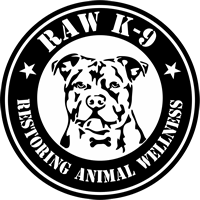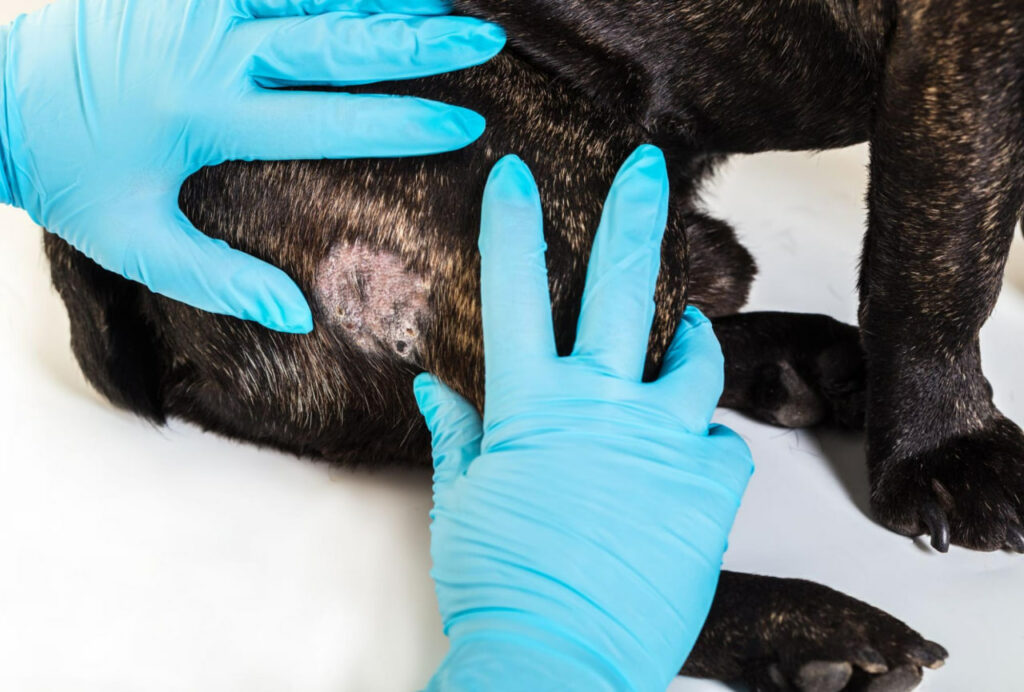
If you notice excessive hair loss in your beloved dog, it’s crucial to investigate the potential factors behind it. One of the frequently encountered causes is a condition called alopecia.
Understanding the root cause will help you address this concern effectively and ensure the well-being of your furry friend.
Let’s dive into what this means.
What Is Alopecia In A Dog?
Alopecia is simply a fancy term for hair loss in dogs. It can be a symptom of several different health problems, or it can be a standalone issue.
It’s important to note that alopecia in dogs doesn’t always mean a serious medical problem. But, if you do notice an increase of hair loss or bald patches on your dog, it’s best to consult with your veterinarian for further evaluation.
Where It Usually Appears
Alopecia can show up anywhere on your dog’s body, but it’s commonly found on the back, belly, and tail. You might notice thinning hair or complete baldness in these areas.
How Seasonal Flank Alopecia Differs
Seasonal flank alopecia is a bit different from regular alopecia. It’s a temporary condition that usually happens during the winter months when there’s less sunlight. But don’t worry, the hair often grows back once the days start getting longer!
Types Of Alopecia In Dogs
There are various types of alopecia that could affect your dog’s health. Let’s take a look at the common ones.
- Pinnal alopecia: This particular type of condition often leads to noticeable hair loss in the region surrounding the ears. It can affect the thickness and volume of hair in those areas, causing a lack of hair coverage and potentially impacting your pet’s overall appearance.
- Pattern baldness: Pattern baldness is commonly caused by a congenital form of follicular dysplasia, resulting in gradual hair thinning due to structural abnormalities or narrowed hair follicles. While follicular dysplasia can cause alopecia, not all types lead to pattern balding.
- Post-clipping alopecia: Sometimes, hair doesn’t grow back after grooming. It’s not a major health concern, but it can be alarming for pet owners when they notice their dog looks bald.
- Post-injection alopecia: Pet owners may notice localised hair loss in the shoulder or neck region of their pets, which is often due to injections given at those sites. These injections can include vaccines, corticosteroids, or other compounds. Hair loss caused by injected steroids can be temporary, with regrowth once the steroid levels subside. Rabies vaccine injections may have a greater impact on certain breeds, particularly small breeds like Poodles, Bichon Frisés, Shih Tzus and Yorkshire and Silky Terriers.
- Colour dilution alopecia: Colour-dilution alopecia is a rare inherited skin disease observed in colour-diluted dogs, predominantly “Blue” ones. It is linked to a specific gene and is characterised by the gradual development of a dry, lacklustre and unhealthy coat.
Symptoms Of Dogs’ Alopecia
Alopecia is not always easy to spot, but if your dog has the condition, they’ll usually show additional signs.
Here are some symptoms to look out for:
- Brittle or dry coat
- More shedding than usual
- Bald patches
- Crusty, inflamed, or red patches around the hair loss area
- Scaly skin
- Dandruff
- Itchy skin
- Overgrooming
- Dark skin patches
Common Dog Breeds Affected By Alopecia
Alopecia in dogs can happen to any breed, but some are more prone than others. Here’s a list of breeds that have the highest likelihood of developing alopecia:
- Greyhounds
- Chinese Crested Dogs
- Dachshunds
- Poodles
- Schnauzers
Common Causes Of Hair Loss In Dogs
There are various potential causes of alopecia in dogs, some being more serious than others.
Here’s what to look out for:
Allergies and Dermatitis
Various factors can contribute to hair loss in dogs, including allergic reactions triggered by certain foods, environmental elements, or even pesky fleas. These irritants can adversely affect their coats and lead to noticeable hair loss.
Hypothyroidism
Hormonal imbalances in a dog can result in a lacklustre coat and hair loss. Typically, these symptoms occur predominantly on the dog’s trunk, while sparing the head and legs. The hair loss often initiates from the tail, causing it to have a distinctive “rat tail” appearance. Additionally, it is common to observe a bald area around the collar.
Cushing’s disease
Dogs with Cushing’s disease often experience hair loss, commonly observed along both sides of the body, over the belly and/or along the tail. This shedding of fur is a common symptom associated with this condition.
Infections
Bacterial or fungal infections, such as dermatophytosis or folliculitis, can cause hair loss in dogs. These infections often target the hair follicles and can result in patches of baldness or a general thinning of the coat. It is important for dog owners to promptly diagnose and treat these infections to prevent further hair loss and discomfort for their furry companions.
Autoimmune diseases
Conditions such as lupus, an autoimmune disease that affects dogs, have been known to cause hair loss. This distressing symptom can occur as a result of the immune system attacking hair follicles, leading to thinning or complete loss of hair in affected areas of the dog’s coat.
Parasitic infestations
Fleas, mites, and ticks are common parasites that can infest dogs, causing them to experience intense itching and discomfort. This relentless scratching can lead to hair loss and skin irritation if not addressed promptly.
Nutritional deficiencies
Hair loss in dogs can occur as a result of deficiencies in specific nutrients, such as essential vitamins and minerals. When these vital elements are lacking in a dog’s diet, it can negatively impact their overall hair health, leading to issues like excessive shedding or even bald patches.
Stress or behavioural issues
Anxiety or behavioural problems in pets can often result in a compulsive behaviour known as overgrooming, where they excessively lick or chew their fur. This repetitive grooming can lead to hair loss, which may further exacerbate their anxiety and create a frustrating cycle for both the pet and their owner.
Trauma
Physical injury to the skin, such as cuts, wounds, or infections, can potentially lead to hair loss in dogs. The hair follicles in the affected area may be disrupted or damaged, inhibiting the normal growth and regrowth of fur.
Cancer treatment
Chemotherapy agents such as doxorubicin may cause hair loss in dogs undergoing cancer treatment. This type of hair loss, known as chemotherapy-induced alopecia, is a common side effect observed in canine cancer patients.
How Veterinarians Diagnose Alopecia In A Dog
If you notice that your dog is experiencing persistent hair loss, it is crucial to consult a veterinarian. They will conduct a thorough examination, taking into consideration factors such as the dog’s medical history, diet, and environment.
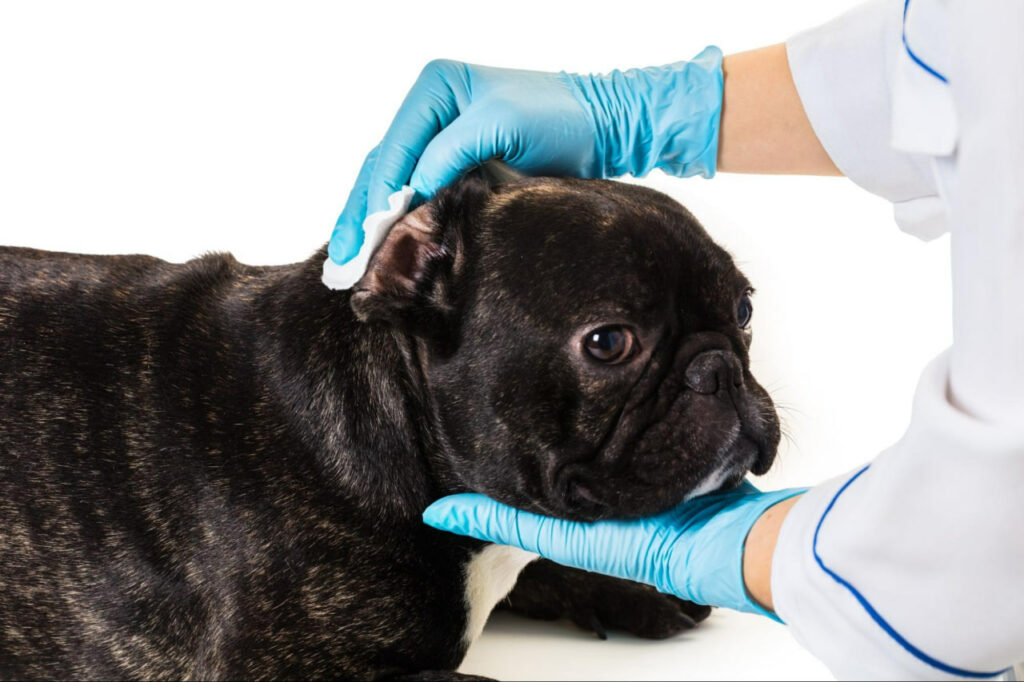
In some cases, the vet might also perform tests, such as skin scrapings or blood work, to determine the underlying cause of the alopecia. This comprehensive approach ensures that the appropriate treatment can be prescribed to address the specific needs of your furry companion.
Possible Treatment Approach
The treatment for alopecia varies depending on the underlying cause. In cases where inflammation is a factor, medications may be prescribed to alleviate the symptoms. If an infection is present, antibiotics may be recommended to address the underlying issue.
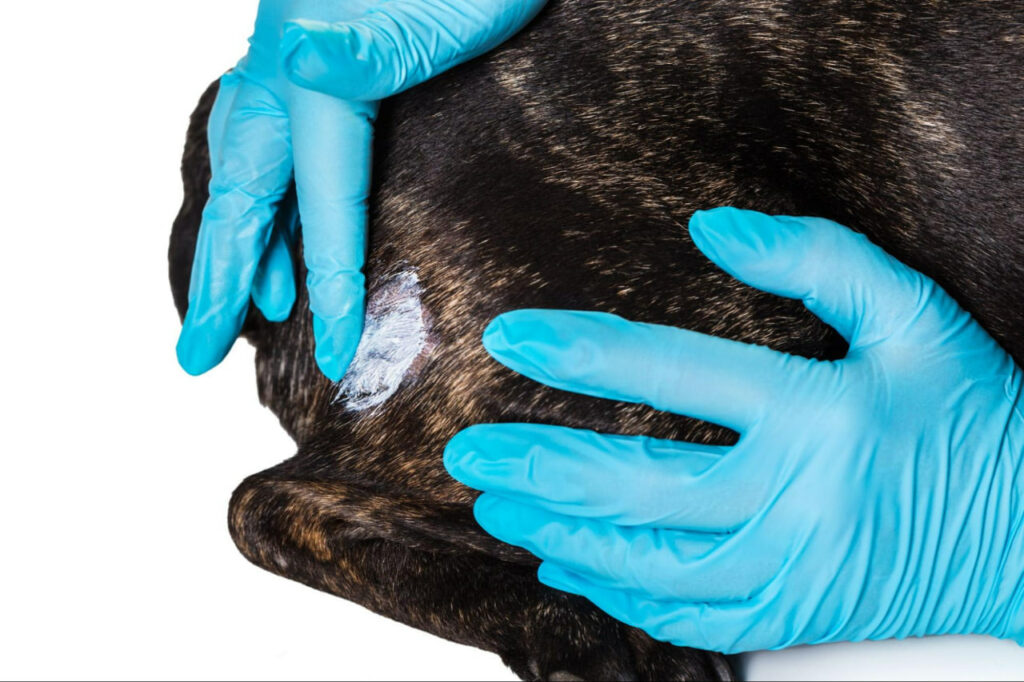
Hormone therapy could be used to regulate hormonal imbalances that contribute to hair loss. Additionally, dietary changes may be suggested to support hair health and growth. In severe cases, surgical options such as hair transplantation may be considered. It is important to consult with a healthcare professional to determine the most appropriate treatment plan for individual circumstances.
Can A Healthy Diet Help Prevent Alopecia From Occurring?
Ensuring your furry friend has a well-rounded and balanced diet, packed with essential nutrients, is key to supporting their overall well-being. Not only does a nutritious diet contribute to their general health, but it also plays a vital role in maintaining the lustre and vitality of their skin and coat.

One way to provide your dog with the necessary nutrients for a shiny and healthy coat is by incorporating raw food into their feeding routine. Raw food offers a natural source of nourishment, delivering a wide range of essential vitamins and minerals that can help promote optimal coat condition.
So, give your canine companion the gift of a radiant and glossy coat through a nutrient-rich diet!
Our Story: Bo’s Remarkable Transformation
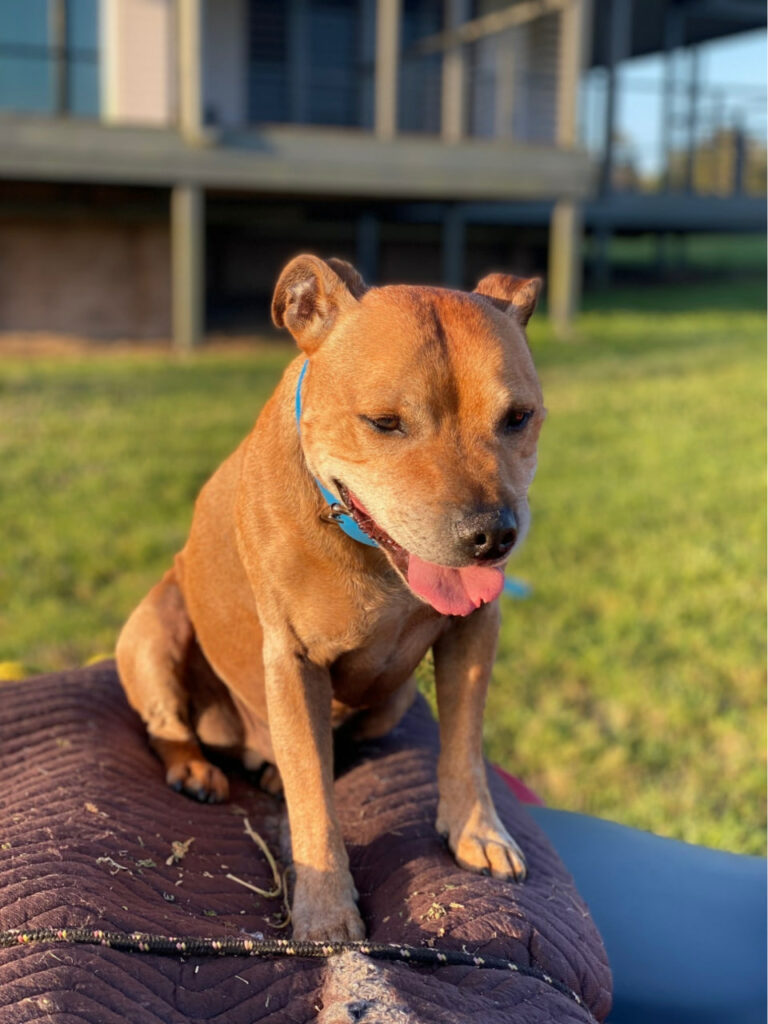
We were eager to switch Bo to a raw diet. First, we tried finding a local company offering balanced meals based on BARF or PMR ratios, but none met our expectations. They lacked crucial ingredients like chunky, wholesome, human-grade meats, green tripe, and edible bones. Plus, we doubted the quality of their minced products, which aren’t ideal for dogs. So, we decided to go the DIY route!First, we became pet nutritionists, learning about raw feeding and the nutritional requirements of cats and dogs. We researched the contents of every ingredient, pet food regulations, and hygiene standards.
We noticed the change in Bo after 1 month. The size and frequency of his stools decreased dramatically, along with the bad dog odours. But the most dramatic difference was his coat.
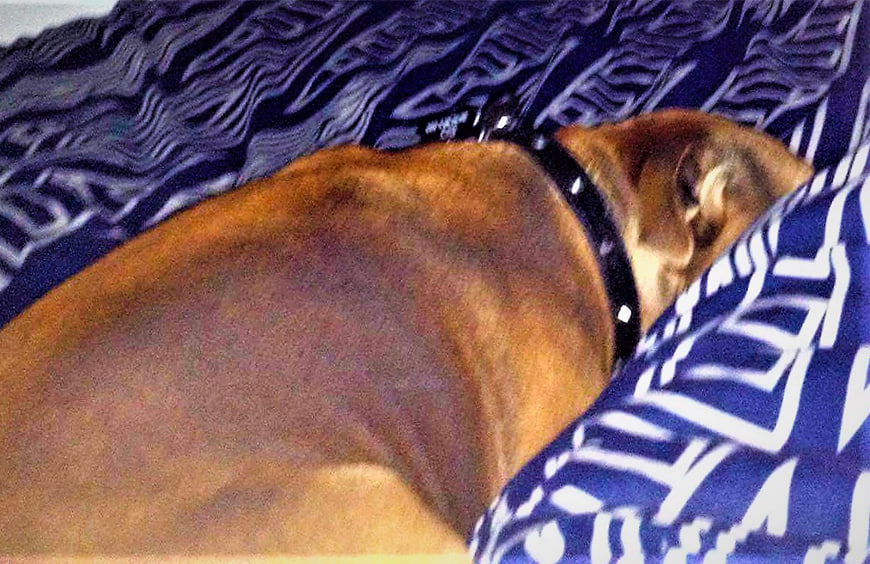
Astonishingly, as you can see here, Bo’s coat began to thicken. We immediately dumped the medicines and focused on Bo’s diet. It wasn’t long before we were raw food converts.
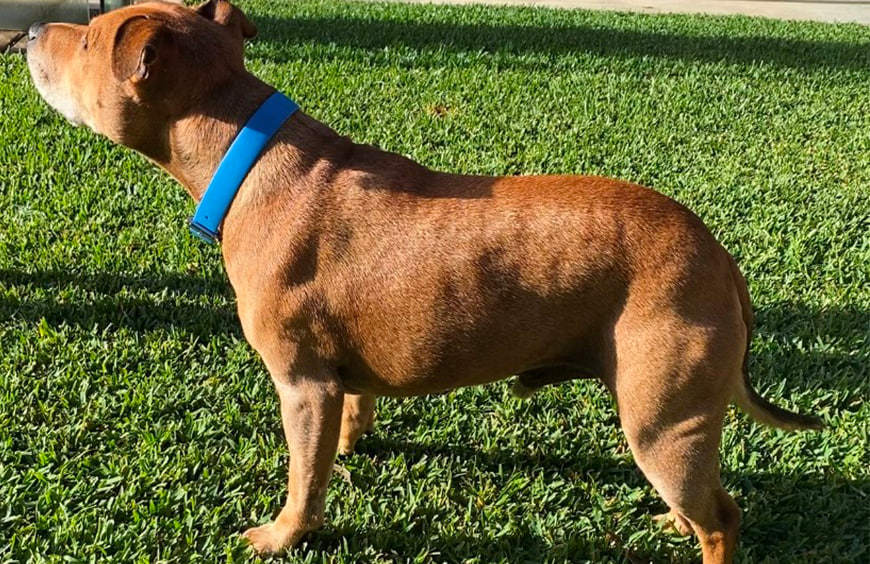
Keep Your Furry Friend Healthy And Safe
Understanding alopecia can help you keep your pet safe and healthy. Remember, a balanced diet and regular vet check-ups are key to preventing health issues.
Are you seeking a wholesome diet for your pet’s vitality? Discover the potential of raw feeding with RAW K-9.
